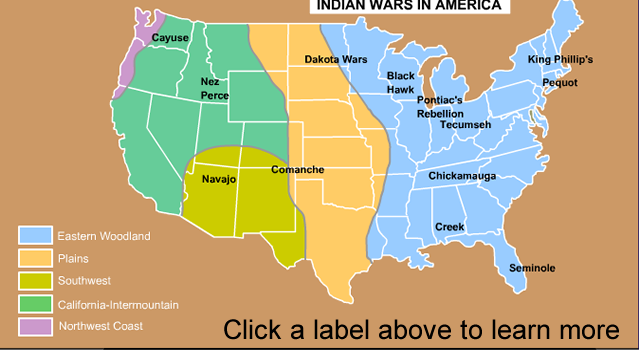America Expands at the Expense of the Sioux
As America expanded in a westward direction in the middle part of the 1800’s, the Sioux nation was force to cede much of their land to the United States government. In 1851, the two sides signed the Treaty of Traverse des Sioux and Treaty of Mendota, which gave the government control of much of the Minnesota territory. As part of the treaty, the Sioux agreed to live on a twenty-mile wide reservation on the upper Minnesota River and the U.S. government agreed to make regular payments and deliver food and goods to the Sioux. Former Sioux lands were quickly developed, which disrupted Sioux hunting, fishing, and planting. In addition, the great herds of buffalo that thundered through the plains just 100 years before were virtually gone.
Violent Conflicts
As the promises made by the U.S. Government in the treaties of 1851 remained unfulfilled, and a terrible famine struck Minnesota, starving members of the Sioux nation lashed out against the settlers in August of 1862. Led by Chief Little Crow, the Sioux nation began attacking settlements and killing settlers. The killings quickly escalated and spread into other parts of Minnesota. For six weeks, intense fighting between the Sioux and settlers raged throughout Minnesota. The violence was finally quelled after Abraham Lincoln appointed General John Pope to assemble troops and suppress the Sioux. At least 500 soldiers died in the conflict as well as several hundred settlers and even more Sioux. 38 Sioux warriors were ultimately convicted of war crimes and hanged in Mankato, Minnesota . The hanging remains the largest public execution in the history of America. None of the executed even had attorneys to represent them. After the hanging, the U.S. Government declared the former treaties with the Sioux null and void, abolished their reservation, and took measures to expel them entirely from Minnesota.
Red Cloud's War
These measures, however, hardly led to any cease-fire. Fighting between the Sioux and U. S. government would continue for almost thirty years. In 1862, the same year of the Minnesota Uprising, government forces and Sioux warriors clashed in Red Cloud’s War. Red Cloud’s War arose over the continued trespassing of White settlers in Sioux land. Gold had recently been discovered in Montana and Wyoming, and thousands of would-be prospectors used the Bozeman Trail to connect with the Oregon Trail. In 1865, the Sioux began attacking wagon trains along the trails. Despite the presence of U.S. military patrols, the Sioux, led by Crazy Horse, used guerilla warfare in hundreds of attacks on the patrols and wagon trains. Eventually, the U.S. government agreed to abandon forts built on the trails if the Sioux stopped their raids. The Sioux celebrated by burning down the forts.
Little Big Horn and the Massacre at Wounded Knee
The Sioux won more victories over the U.S. Army in various battles in the Black Hills of South Dakota and Wyoming. In perhaps the most famous battle in all of the Indian Wars, Sioux and Cheyenne Indians obliterated the entire Seventh Calvary under George Custer at the Battle of Little Big Horn in 1876. The infamous battle, in which the entire 250-man cavalry was killed, is known as Custer’s Last Stand. Further battles, however, proved disastrous for the Sioux and other Plains tribes. U.S. government forces soon overwhelmed the tribes of Plains, and dealt them a final blow during the Massacre of Wounded Knee of 1890. In the last battle of the Indian Wars, as many as 300 Sioux were killed as they believed their “Ghost Shirts” would protect them from government bullets. The government, alarmed by the increasing number of Sioux that had taken up arms (and who had been performing forbidden “ghost dances,”) initiated the first shots when a gun accidentally discharged.
Click on the text in the map to learn about each of the U.S. Government-Indian Wars. |

|